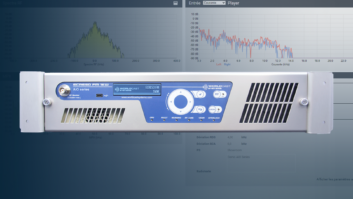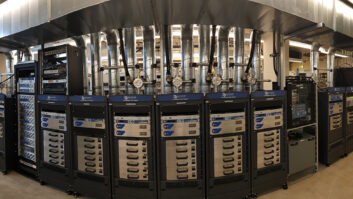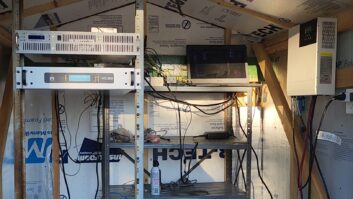Update on Transmitters
Apr 1, 2014 8:55 AM, By Doug Irwin, CPBE DRB AMD

At least once every year we take a look at new features in transmitters. LPFM is in our industry news quite a bit as of late, so we’ll look at some equipment that could be used for LPFM as well: small, stand-alone transmitters, and some low-power antennas.
Nautel is introducing its newest transmitter line, the GV series. This is an evolution of the NV design, which (according to Nautel) provides better analog and digital efficiency than its predecessor. Power levels range from 3.5kW to 80kW, and it has some very interesting (and more importantly, useful) features, with respect to RF generation:

Nautel GV Series
� HD PowerBoost is a standard feature
� Asymmetrical digital sideband support
� Adaptive pre-correction
� Hot-swappable RF amp modules and power supply modules
� Integrated digital exciter, optional backup exciter
� No IPA
� Field-repairable amplifier pallets
Of course in this day and age we all look beyond just the RF-generation aspects of a transmitter, to its monitor and control capabilities; as the number of functions around the radio station increases for the average broadcast engineer, it’s important that each and every one of them is made as easy and efficient as possible. Remote access and control of a transmitter is one of the most important of these tasks. Toward that end the GV series offers the following features:
� The Nautel AUI (Advanced User Interface), which provides local control (via a 17″ touchscreen monitor) and remote access with definable security and access levels on a per-user basis
� MER and a full suite of HD Radio instrumentation with spectrum analyzer and constellation view
� UPS support for control electronics and loss-of-ac-power recovery speed
� SNMP support
Nautel has been adding non-traditional features to transmitters as well. Program sources can be traditional composite or AES; or IP, USB or Livewire. Orban inside is an optional feature for processing; the exciter also supports MPX over AES from Omnia, Orban and Wheatstone. Nautel Phone Home is a system that pro-actively collects data from the transmitter and forwards it to Nautel for later analysis should a problem arise.
– continued on page 2
Update on Transmitters
Apr 1, 2014 8:55 AM, By Doug Irwin, CPBE DRB AMD

GatesAir Flexiva
Harris Broadcast has rebranded its radio line as GatesAir, and the company has not been resting on its laurels. The Flexiva series is now available from the FAX50 up to the FAX3.5K (which tops out at 3.85kW). The series has an integrated low-pass filter, and so each can operate as a standalone transmitter. Coming soon for the Flexiva series is the new Generation 4 HD Radio Exgine, which will feature hybrid crest factor reduction, asymmetrical sideband generation, MER metrics and advanced real-time adaptive correction. Some of the other particularly interesting features of the Flexiva series are:
� Support for Single Sideband — Suppressed Carrier (SSB-SC) stereo mode operation
� ITU 812R multiplex power limiter
� External 10MHz and I PPS clock reference inputs for synchronization purposes in single-frequency networks; optional GPS receiver
� Low-power preset mode, for easy power-reduction during tower work
� Remote control via eight assignable GP I/O, Web access, SNMP
� Optional Orban 5500H internal audio processor
� Accepts MPX over AES192 from Orban, Omnia and Wheatstone processors
Gates Air has also developed an IP audio codec that can transport MPX/AES192 over Ethernet (a world’s-first, according to the company). This will allow the audio processors, RDS, and SCA generators to be located back at the studio — sending the entire composite package to the transmitter site by way of IP.

Broadcast Electronics STX LP
The latest product line from Broadcast Electronics is the STX LP series — in power levels from 1kW to 5kW. You could consider the STXe, which is based on the STX design, for power leverls between 70 and 550W. The STX LP is a scalable design that (according to BE) will accommodate current and future system configurations, such as main/alternate main, FM single-frequency networks, and N+1 applications. Some of the other STX-LP important features:
� Integral exciter
� RF input that accommodates external exciter
� Integral low-pass filter
� Composite input, with 2 SCA ports and RDS port
� Plug-in stereo generator accepting L/R or AES
� Integral back-up controller
� Front-panel control, metering via LCD interface
� Embedded Web server allowing IP access
The STX LP 1kW occupies 3RU. The 2kW STX occupies 10RU, the 3kW occupies 13RU, and the 5kW occupies 19RU. BE also can provide its Advanced Remote Graphical Interface (RGUI) that allows for Web-enabled control of up to eight STX-LP transmitters, also providing the means to view transmitter and PA data and logs.
– continued on page 3
Update on Transmitters
Apr 1, 2014 8:55 AM, By Doug Irwin, CPBE DRB AMD

Continental Electronics 816R-7C
Continental Electronics has maintained its familiar line of high-power FM transmitters, the 816R series. Power levels range from 11kW to 21.5kW (using the 816R-2C) up to 40kW (the 816R-7C). A single tube is deployed as the final amplifier (4CX15000A, 4CX20000E or 4CX25000C depending on the power level). All of the series are self-contained, except the 816R-7C, which uses a separate power supply cabinet and external harmonic filter.
The 816R-HDR (HD-ready) is a high-power combined amplifier for IBOC applications. It can be purchased as an FM-only transmitter, while planning to add the IBOC components (the Exgine-enabled 802Ex digital FM exciter, along with an exporter) later. Continental’s D816HD series transmitters range in combined TPO from 18kW to 56kW at HD power levels of -20dBc to -10dBc. These combined transmitters use only one tube each, the final power amplifier tube. The D816HD Series Transmitters are also completely self-contained, including the harmonic filter. (The 70kW has two high-voltage rectifiers and plate transformers located in two separate chassis.) D816HD transmitter systems work with Continental’s 802Ex digital FM/HD Radio exciter to provide forward looking fully adaptive pre-correction, system and digital performance monitoring and on-channel spectral analysis.
To the low side
LPFM stations are those authorized to operate as noncommercial educational stations, with an ERP of 100W or less. The maximum facility is 100W ERP with an antenna HAAT of 30 meters. The approximate service range (60dBu) of an LPFM is 3.5 miles in radius. LPFM stations are not protected from interference that may be received from other classes of FM stations.
During the last filing window (which was held between Oct. 15 and Nov. 14, 2013) 2,800 applications were received by the Commission; as of the time of this writing, about 1,000 LPFM CPs have been granted.
If you happen to be holding one of the aforementioned CPs, you might wonder what to do next. To create a maximum facility for an LPFM, consider this: a single-bay, circularly polarized antenna, with about 200W making it to the antenna input port. There are quite a few options in transmitters that are capable of 300W.

BW Broadcast TX300 V2
BW Broadcast has come on strong in the last half-dozen years. It offers the TX300 V2, a stand-alone transmitter capable of 300W. One box houses the exciter, power supply, power amplifier, a stereo generator and audio processor (basically lifted right from the design of the BW DSPX miniFM). Audio inputs are balanced XLR. The internal audio processor can be bypassed if an external unit will be used to drive the BNC composite input of the transmitter. The RF output is on a type-N female. The ac input can accept between 85Vac and 260Vac, which yields some flexibility with the installation. Remote control can be done via RS-232, requiring a computer at the transmitter site for remote access; or, via its new software, Ethernet access to the transmitter can be had via its embedded Web interface. In either case the transmitter site will need network access.
– continued on page 4
Update on Transmitters
Apr 1, 2014 8:55 AM, By Doug Irwin, CPBE DRB AMD
Armstrong is another established presence in transmitters. Its line of solid-state transmitters include the STX, LCD and B series, and are available nearly any power level. The 300W power amplifier is built on the Philips BLF 278 MOSFET. The FMX exciters provide output powers of 30, 150 and 300W. The FMX LCD series of exciters provide outputs of 30 or 100W. The FMX LCD’s can be switched between five preset frequencies via remote control.
On the low-power amplifier side, Armstrong offers the FM-300S, FM-500SC and FM-500LCD with power levels of 300 and 500W.

Crown Broadcast E Series
Crown Broadcast, well known in lower power stand-alone FM transmitters, now offers its E Series (built by Ecreso). The E Series features a direct-to-channel integral exciter, and the 350W version occupies 3RU, with 17″ of depth. It’s a good idea to allow a rack space above and below for cooling purposes. The integral stereo generator accepts L/R analog or AES at up to 192kHz sample rate and up to 32-bit word length. It also has two BNC inputs for composite or SCAs.
An option for the E Series is a TCP/IP communications board that allows for the use of a Web-based interface for monitoring and remote control, along with SNMP support. Use of this optional board also allows support of Crown’s Advanced Measurement Interface, as well as a feature known as Expert Maintenance reporting, which is a proactive reporting service that allows for the monitoring of parameters such as temperatures, currents and voltages, plus performance parameters of lifespan-constricted items such fans. These measurements are sent via a regular Internet connection, stored in the cloud and available for analysis by the manufacturer later on, should the need arise.

Bext LEX
Bext is also established in FM transmission equipment. For an LPFM application, the LEX series applies, which tops out at 300W. The LEX is a 1RU, frequency-agile transmitter, with integral stereo generator. Output power is continuously adjustable from zero up to the maximum power rating, and it has proportional power fold-back in response to high VSWR. The power supply accepts between 95Vac and 260Vac, which gives some flexibility in the installation. (LEX also includes and FSK ID keyer, should that be needed for translator use.) The LEX series also meets or exceeds FCC specs on spectral purity, and can be used as a stand-alone transmitter.
– continued on page 5
Update on Transmitters
Apr 1, 2014 8:55 AM, By Doug Irwin, CPBE DRB AMD

Broadcast Electronics STXe
Keep in mind that the manufacturers of higher power transmitters also make units that will work great in LPFM applications. For example, Broadcast Electronics offers the STXe for power levels between 70 and 550W (more than enough for any LPFM application). Aside from the integral controller, it has an integral low-pass filter, meaning it can be used as a stand-alone transmitter. It also has an updated GUI, so if the site has IP access, complete remote access is available. SNMP support is also included. With the addition of VPe (Vector Power Enhancement) this exciter can also be used in HD radio applications in FM + HD Radio, or HD Radio only. For those outside the U.S, this exciter can also be used for FM + DRM+ applications.

GatesAir Flexiva FAX300
GatesAir makes the Flexiva series of transmitters and the FAX300 would be appropriate for the many LPFM applications. It includes a direct-to-carrier modulator, with integral stereo generator, and integral low-pass filter, meaning it can be used as a stand-alone transmitter. (The FAX50, FAX150, FAX300, FAX500 and FAX1kW are fully FCC type accepted for LPFM.) Its stereo generator has analog L/R inputs along with two AES inputs, and a built-in RDS generator. AC power input uses between 90Vac and 277Vac. It’s 3RU and 20.5″ deep. FAX300 comes with an embedded Web interface, SNMP support, and local GP I/O as well. Flexiva 300 can be used for HD Radio or DRM+ as well.

Nautel VS300LP
Nautel offers the VS300LP, which is a special version of the VS300, type-accepted for LPFM applications. Like all the other transmitters we’ve looked at, the VS300LP has an integral exciter; it uses direct-to-channel modulation, and comes with an integrated stereo generator, and SCA and RDS generators. The VS300LP accepts an AES program input, L/R analog inputs, composite, or IP streams such as Shoutcast, RTP, or Livewire. It also supports MPX over AES for a completely digital connection to many audio processors. Maximum power is 330W (analog only), and it’s 2RU and about 25″ deep with a type-N female connector output. The ac input voltage can operate between 180Vac and 264Vac. Remote access is done via the Nautel AUI, which gives the user complete monitoring and control via IP; parallel control and SNMP access are supported as well.
The evolution of FM transmission continues. After years of using tube transmitters, solid-state has now become commonplace. HD Radio has been thoroughly integrated into new products. The latest trends have mainly to do with the addition of IP access at transmitter sites: Web access, remote control, and the use of streaming audio. As transmitters become more reliable, and require less routine maintenance, they don’t require as many hands-on visits, and so the ability to see their operation remotely has become more important than ever. The new design features are indicative of how communication has evolved, with ubiquitous IP access and Ethernet. I hope if you are looking at a new transmitter purchase that you’ll embrace these new aspects of the art.
Irwin is RF engineer/project manager for Clear Channel Los Angeles. Contact him at [email protected].
April 2014
Update on transmitters, a new production vehicle for the Motor Racing Network, studio furniture, new products at the 2014 NAB Show and more….












